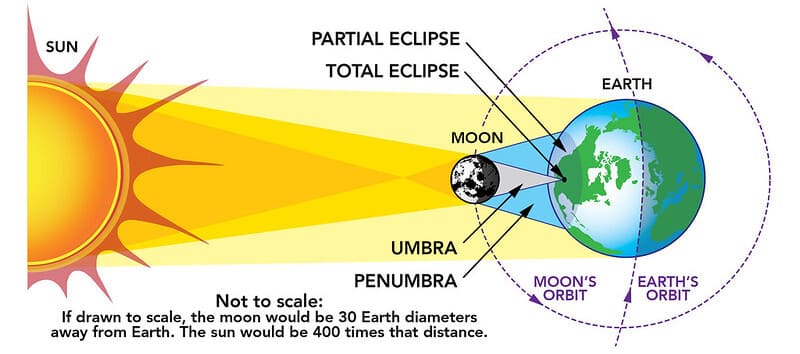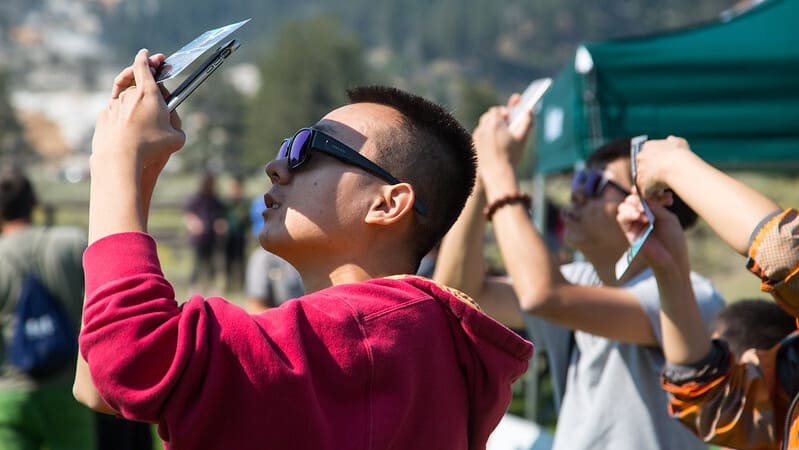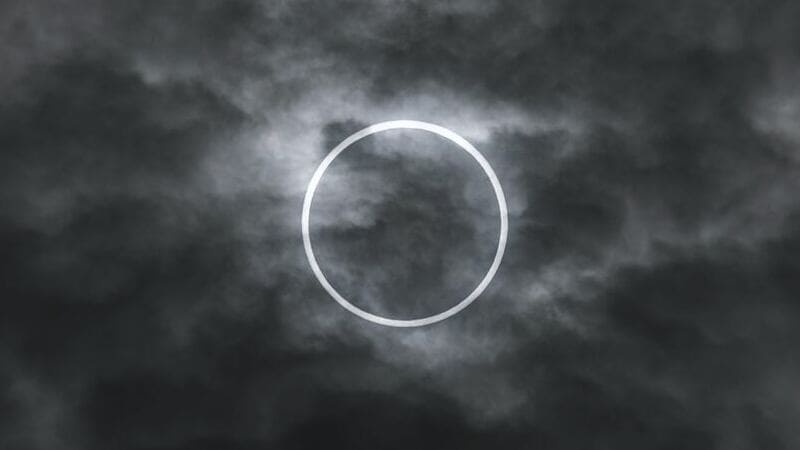Welcome to the world of solar eclipse photography, where science meets art and the cosmos paints its mesmerizing masterpiece across the sky. Have you ever wondered, “Can I take a photo of a solar eclipse?” If so, you’re about to embark on a journey filled with celestial wonders and photographic adventures.
In short, Yes, you can take a photo of a solar eclipse, but the real magic lies in how it’s done safely and beautifully. Join me through this ultimate guide to unravel the secrets and techniques that turn a simple “yes” into a captivating photographic adventure you won’t miss.
In this article, you get to
Understand Solar Eclipses: Gain a clear understanding of what a solar eclipse is and how it occurs.
Identify Types of Solar Eclipses: Learn about the four main types of solar eclipses – total, partial, annular, and hybrid – and the unique characteristics of each.
Safety Considerations: Understand the risks of photographing a solar eclipse and the importance of protecting your eyes and digital camera.
Safety Equipment: Learn about the essential safety equipment, including solar eclipse glasses and camera solar filters, necessary for safe eclipse viewing and photography.
Optimal Photography Setup: Explore considerations for choosing the right camera, camera lens, tripod, and other gear for photographing a solar eclipse.
Choosing Solar Filters: Understand the different types of solar filters available and their advantages and disadvantages.
Camera Settings and Focus: Discover the best camera settings and focus techniques for capturing the various phases of a solar eclipse.
Conducting the Eclipse Photography Session: Get tips on preparing for your eclipse photography session, including location selection and backup planning.
Post-Processing and Enjoyment: Learn about post-processing techniques to enhance your eclipse photos and the importance of enjoying the eclipse experience beyond photography.
By the end of this article, you’ll be fully equipped with the knowledge and confidence to safely and successfully photograph a solar eclipse, capturing its awe-inspiring beauty and creating lasting memories.
Let’s dive right in.
Recommended For You
Understanding Solar Eclipses

Definition of a Solar Eclipse
A solar eclipse happens when the moon comes between the sun and the Earth, blocking some or all of the sun’s light from reaching us.
The moon’s shadow has two parts: the umbra and the penumbra.
The umbra is the dark inner part of the shadow, where the moon completely hides the sun. The penumbra is the lighter outer part of the shadow, where the moon partially covers the sun.
Depending on which part of the shadow you are in, you will see a different type of solar eclipse.
Types of Solar Eclipses
There are four main types of solar eclipses: total, partial, annular, and hybrid.
- A total solar eclipse occurs when the moon completely covers the sun’s disk, creating a dark circle in the sky with a bright ring of light around it. This is also called the solar corona, the sun’s outer atmosphere. During a total solar eclipse, you can also see some features on the sun’s surface, such as sunspots and prominences. A total solar eclipse can only be seen from within the umbra.
- A partial solar eclipse occurs when the moon partially covers the sun’s disk, creating a crescent-shaped sun in the sky. A partial eclipse can be seen from within the penumbra or from outside the shadow.
- An annular solar eclipse occurs when the moon is too far away from Earth to cover the sun’s disk completely, leaving a bright ring of light visible around it. This is also called an annulus or a ring of fire. An annular solar eclipse can only be seen within the antumbra, extending the umbra beyond Earth.
- A hybrid solar eclipse occurs when the type of eclipse changes along its path. It can start as an annular eclipse and end as a total eclipse, or vice versa. A hybrid solar eclipse can be seen within different shadow parts.
Safety Considerations: Can I take a photo of a solar eclipse?

Risks Involved
Photographing a solar eclipse can be dangerous if you do not take proper precautions. Looking directly at the sun without adequate protection can cause permanent eye damage or blindness.
Read my related article to learn if you can look at a solar eclipse without sunglasses
This is because the sun emits intense ultraviolet (UV) rays that can burn your retina, which is the light-sensitive layer at the back of your eye. Even if you do not feel any pain or discomfort, you may not notice any symptoms until hours or days later.
The only time it is safe to look directly at the sun without any protection is during totality or annularity when the moon entirely or almost completely covers the sun. However, this phase lasts only for a few minutes at most, and you need to be very careful about when to put on and take off your protective eyewear.
Safety Equipment

The most essential equipment for viewing and photographing a solar eclipse is a solar filter.
A solar filter is a particular device that blocks most of the sun’s light and UV rays, allowing you to see the sun safely. This is not an ND filter.
There are two types of solar filters: one for your eyes and one for your camera.
Solar filter for your eyes
You need to wear solar eclipse glasses or a handheld solar viewer for your eyes. These are made of cardboard or plastic with a thin layer of black polymer or aluminized Mylar that filters out harmful rays. Do not use sunglasses, binoculars, telescopes, or any other optical device without a proper solar filter, as they can magnify the sun’s rays and cause more damage.
Solar filter for your camera
For your camera, you need to attach a solar filter to the front of your lens. This can be a screw-on filter, a clip-on filter, or a homemade filter using a sheet of solar filter material. Do not use a neutral density (ND) filter, a polarizing filter, or any other type of photographic filter, as they are not designed to block the sun’s UV rays. Also, do not use the camera’s viewfinder to look at the sun, as the filter may not cover it completely. Use the camera’s LCD screen or an external monitor instead.
Optimal Setup for Photographing a Solar Eclipse

Gear Considerations
The type of camera and lens you use for photographing a solar eclipse depends on your personal preference and budget.
Here are some general guidelines to follow:
- You can use any camera: manual camera, mirrorless, DSLR camera, point-and-shoot, or smartphone camera. However, a camera with manual mode and RAW format will give you more control and flexibility over your exposure and post-processing.
- You can use any lens: zoom lens, prime, wide-angle, or telephoto. However, the longer the lens’s focal length, the larger the image of the sun you can capture. For example, a 300mm lens will produce an image of the sun that is about 3mm in diameter on a full-frame sensor. A 600mm lens will produce an image that is about 6mm in diameter. A 1200mm lens will produce an image that is about 12mm in diameter. You can also use a teleconverter or an extender to increase the effective focal length of your lens.
- You will also need a sturdy tripod to stabilize your camera and avoid camera shake. A remote shutter release or a self-timer will also help you avoid touching the camera during the exposure.
Choosing Solar Filters
As mentioned before, you need to use a solar filter on your lens to protect your camera and your eyes from the sun’s rays.
There are different types of solar filters available, each with its own advantages and disadvantages:
- A screw-on filter is a circular filter that screws onto the front of your lens. It is easy to use and secure, but it may not fit all lenses and cause vignetting (darkening of the corners) on wide-angle lenses.
- A clip-on filter is rectangular and clips onto the back of your lens. It is compatible with most lenses and does not cause vignetting, but it may be challenging to install, remove, and interfere with autofocus.
- A homemade filter is made using a sheet of solar filter material and some cardboard or tape. It is cheap and customizable but may not be very durable or reliable, affecting image quality.
You can find more information about making your own solar filter in my DIY Solar Filter article.
Camera Settings and Focus
The best camera settings for photographing a solar eclipse depend on the type of eclipse and the phase you capture.
Here are some general tips to follow:
- Use manual mode to have complete control over your exposure settings.
- Use a low ISO (100 or 200) to reduce noise and increase dynamic range.
- Use a fast shutter speed (1/1000s or faster) to freeze the motion of the sun and moon and avoid overexposure.
- Use a small aperture (f/8 or smaller) to increase depth of field and sharpness.
- Use manual focus to ensure accurate focus on the sun. Autofocus may not work well in low light conditions or with a solar filter. You can use the live view mode or an external monitor to magnify the image of the sun and adjust the focus ring until it is sharp and clear.
You may need to adjust your settings depending on the brightness of the sun and the ambient light. You can use a histogram or an exposure meter to check your exposure level. You can also take test shots and review them on your camera or computer screen.
Related Content: Can You See Stars During a Solar Eclipse?
Conducting the Eclipse Photography Session

Preparation
Before photographing the solar eclipse, you need to prepare to ensure a successful and enjoyable experience.
Here are some things to consider:
- Check the weather forecast and choose a location that has a clear view of the sky and the horizon. Avoid crowded, noisy, or obstructing places like buildings, trees, or power lines.
- Arrive early and set up your equipment well before the eclipse begins. Ensure your camera battery is fully charged and you have enough memory space. Test your camera and lens with the solar filter and ensure everything works properly.
- Plan your shots and decide what phases of the eclipse you want to capture.
- Have a backup plan in case something goes wrong. For example, have a spare camera, lens, filter, battery, or memory card. Also, have a phone, a radio, or a watch to keep track of time and communicate with others.
Composition and Framing
The composition and framing of your solar eclipse photo will depend on your personal style and preference.
Here are some tips to help you create a compelling image:
- Use the rule of thirds to place the sun off-center in your frame. This will create a more dynamic and balanced composition than placing it in the middle.
- Include some foreground or background elements to add context and interest to your photo. For example, you can use silhouettes of people, animals, buildings, mountains, or trees to create contrast and scale.
- Experiment with different perspectives and angles to capture various aspects of the eclipse. For example, you can use a wide-angle lens to capture the entire scene or a telephoto lens to zoom in on the details.
- Be creative and try different techniques such as multiple exposures, panoramas, time-lapses, or HDR (high dynamic range) to create unique effects.
Capturing the Different Phases of the Eclipse

The most exciting part of photographing a solar eclipse is capturing the different phases of the eclipse as it progresses. Each stage has its own characteristics and challenges that require different settings and techniques.
Here are some guidelines for each phase:
- The partial phases are when the moon starts to cover or uncover the sun’s disk. During these phases, you need to use a solar filter on your lens to protect your camera and your eyes from the sun’s rays. You can use a fast shutter speed (1/1000s or faster) and a small aperture (f/8 or smaller) to capture the shape of the sun and moon. You can also use a bracketing technique to take multiple shots with different exposures and combine them later in post-processing.
- The totality or annularity is when the moon completely covers or almost covers the sun’s disk, creating a dark circle in the sky with a bright ring of light around it. During this phase, you need to remove your solar filter from your lens to capture the details of the corona, which is the sun’s outer atmosphere. You can use a slower shutter speed (1/60s or slower) and a larger aperture (f/5.6 or larger) to capture the brightness and color of the corona. You can also use a bracketing technique to take multiple shots with different exposures and combine them later in post-processing.
- The diamond ring is when a bright spot appears on the moon’s edge as it covers or uncovers the sun’s disk. This is also called Baily’s beads, which are caused by sunlight shining through valleys on the moon’s surface. During this phase, you must be very quick and careful as it lasts only a few seconds. You need to use a solar filter on your lens until you see the diamond ring appear, remove it for one shot, and then put it back on. You can use a fast shutter speed (1/1000s or faster) and a small aperture (f/8 or smaller) to capture the shape and brightness of the diamond ring.
Post-Photography Session
Post-Processing
After taking your photos of the solar eclipse, you can use a software program such as Adobe Photoshop, Lightroom, or GIMP to edit and enhance them.
Here are some things you can do in post-processing:
- Crop and rotate your photos to improve the composition and alignment.
- Adjust the exposure, contrast, white balance, and color to correct any errors or inconsistencies.
- Sharpen and reduce noise to improve the clarity and quality of your photos.
- Stitch multiple photos together to create a composite image or a panorama.
- Add filters, effects, or text to create a more artistic or informative image.
Enjoy the Moment
Photographing a solar eclipse can be a rewarding and memorable experience, but it can also be stressful and challenging. It is vital to balance your photography endeavor with enjoying the moment itself.
Here are some tips to help you enjoy the moment:
- Remember to look at the eclipse with your own eyes (with proper protection) and appreciate its beauty and wonder.
- Don’t get too obsessed with getting the perfect shot and miss the opportunity to witness the event.
- Refrain from letting technical issues or mistakes ruin your mood and enthusiasm.
- Don’t be afraid to experiment and have fun with your photography.
Summary: Take a Photos of Solar Eclipse
Thank you for reading my article, “Can I take a photo of a solar eclipse.”
Photographing a solar eclipse can be a rewarding and memorable experience, but it requires some preparation, safety measures, and technical skills.
In this article, I have covered everything you need to know to capture amazing photos of a solar eclipse, from understanding the types and phases of eclipses to choosing the right equipment and camera setting, composing and framing your shots, and editing and enhancing your photos. I hope you have found this article helpful and informative, and I wish you good luck and clear skies for your next solar eclipse photography session.
Are you interested in more Solar Eclipse articles?
- Does It Get Dark During a Solar Eclipse?
- Are Stars Visible During a Solar Eclipse?
- How Long Do Solar Eclipses Last?
- How often are Solar Eclipses in the US?
- Can you look at a solar eclipse without sunglasses?
- How Do Solar Eclipse Glasses Work?
- DIY Solar Filter Telescope: 5-Step Easy Guide
- What is a Hybrid Solar Eclipse?



